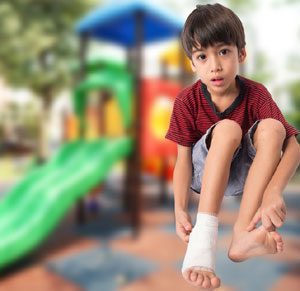
Many troublesome foot and ankle conditions occur in children just as they do in adults. But the bones of growing children haven’t themselves finished growing, so some children’s foot problems require extra attention.
What is a child’s growth plate?
Sites of active bone growth in children are called growth plates. They exist near the ends of bones in pre-adolescent children. As a child’s bones are maturing, the growth plates are the softest and weakest parts of their skeleton.
When do growth plates close?
Girls’ growth plates have generally matured into solid bone and closed around the age of 13 to 15. Boys’ growth plates close a little later, usually by age 16 or so.
Damage to growth plates can result in long-lasting harm, so it’s important to pay attention to injuries that may have caused damage to your child’s growth plates. Here are 5 foot and ankle conditions to watch for in your child.
1. Sprains vs Strains

This often means different parts of the body are strenuously moving in different directions at the same time. When those moves involve the feet, a sprain or strain of an ankle is a frequent result.
The bones and muscles of children’s feet are tightly bound together by cords of a tough material called collagen. Ligaments are the resilient straps of collagen that bind one bone to another bone. The cords of collagen that bind muscles to bones are called tendons.
What is a sprain?
When a ligament is overstretched or torn, the resulting injury is a sprain.
What is a strain?
A torn or overstretched tendon (or muscle) is a strain.
A child’s growth plates can get damaged
Because the components of a child’s ankle are immature, an ankle sprain or strain can be more serious to a child than it would be to an adult. A child’s growth plates can be permanently damaged by the same forces that cause a sprain or strain.
The symptoms of both sprains and strains include pain, bruising, limited movement, and instability. A strain can also cause muscle spasms and weakness.
Treatment for ankle sprains and ankle strains is pretty much identical
The acronym of RICE describes the standard treatment for each condition: rest, ice, compression, and elevation. In other words, minimize use of the affected ankle, ice it down, bind it with an athletic bandage, and spend as much time as possible with the ankle elevated.
And remember those growth plates. See your podiatrist for even moderate sprains or strains in your child’s ankle.
2. Sever’s Disease
This painful condition in a child’s heel is linked to repetitive overuse. So Sever’s disease most often occurs in a sports context, especially in sports such as soccer and football, where sudden and violent changes of direction are the daily training norm.
The overuse causes inflammation of the growth plate in the heel. The result is pain in the lower heel, where the Achilles tendon joins the large heel bone (aka the calcaneus).
What is the treatment for Sever’s disease?
Treatment for Sever’s disease is generally pretty simple. Give it a rest. Some physical therapy can be helpful, but generally anti-inflammatory medications and usually time will heal this heel problem. However, severe cases will require podiatric intervention.
3. Bunions
Bunions are bony protrusions at the base of the big toe. The origin of bunions is often hereditary, and girls are more susceptible than boys.
Generally speaking, a bunion is the consequence of a structural misalignment of the joint between the big toe and the first metatarsal. The big toe leans over toward the smaller toes. This causes the big toe joint to jut out toward the other big toe.
Bunion surgery and growth plates
Bunion surgery is available, but it’s only indicated when the pain is consistently severe and normal activities are significantly hindered. Because bunion surgery can compromise growth plates in children, exhaustion of nonsurgical options is imperative.
On commong non-surgical option are toe spacers and splints that realign the big toe can be utilized together with orthotics to restructure the affected joint.
4. Stress Fractures and Tendinitis
Like Sever’s disease, stress fractures and tendinitis are linked with overuse. They occur most often in young athletes. They won’t interfere with your child’s growth plates, but they can cause a lot of pain, interrupt daily activities, and limit sports participation. Fortunately, stress fractures and tendinitis also respond well to rest.
5. Flat Feet in Children
Children’s feet normally come from the factory flat as a pancake. When infants or toddlers are standing, the entire soles of their feet contact the surface they’re standing on. By the time they reach the age of six, most children’s feet have developed arches.
When a kid’s feet stay flat after the age of six, this condition is known as pediatric flatfoot, or pes planus. (It might better be named pediatric flatfeet, because they come in pairs. Having only one flat foot is rare.)
Pediatric flatfoot is frequently symptom-free, and therefore requires no treatment, or even any attention (just another mildly weird kid). It also won’t interfere with growth plates.
But when pediatric flatfoot is accompanied by pain, cramping, awkwardness in walking, or an inability (or unwillingness) to participate in physical activities, it’s time to visit your podiatrist.
Treatments for pediatric flatfoot
- The first step will be to temporarily eliminate or reduce the activity that’s causing the symptoms.
- Non-steroidal anti-inflammatory medication (like ibuprofen) may be recommended to reduce pain and inflammation.
- Next, orthotics will be considered. These devices fit inside a shoe. They support the foot’s structure and improve its function.
- Physical therapy, including stretching and strengthening exercises, can provide relief in many pediatric flatfoot cases.
- Pediatric flatfoot surgery. In some rare and severe cases, pediatric flat foot surgery may be required to alleviate persistent pain.
Preventing foot and ankle injuries in kids
The growth plates in children’s bones are not completed until their later teen years, and these immature bones, together with the surrounding tendons and ligaments, are more susceptible to both traumatic and stress injuries. So, although practice does lead toward perfection, proud parents with visions of future scholarships dancing in their heads, as well as ambitious coaches who may over-emphasize winning, need to recognize and avoid the perils of overtraining.
Proper footwear, including shoes specifically designed and constructed for a single sport, is also an important component of an effective sports injury prevention program. Don’t let your child’s sentimental attachment to that old worn-out, rundown pair of soccer boots keep you from providing shoes with complete lateral support and full-length cleats.
Parents can help coaches and referees examine playing fields in search of gopher holes, divots, and loose earth, all of which are nothing more than sprains and strains (or fractures) waiting to happen.
Parents should also make certain that their children’s coaches are committed to a program of systematic injury prevention, and that each coach is fully trained in advanced first aid.
Formal warm-ups, including supervised and thorough stretching exercises, should be part of every youthful athlete’s pre-game routine, and cool-down sessions, again including stretches, should follow every participation. Don’t forget adequate hydration.
Finally, but of paramount importance, a preseason physical examination by a podiatric professional, such as those offered by the physicians of UFAI, is valuable insurance against latent foot and ankle problems that can suddenly turn into serious and long-lasting injuries.
Why choose University Foot and Ankle Institute for your children’s foot and ankle care?
If your child is experiencing foot problems, we’re here to help. Our nationally recognized foot and ankle specialists offer the most advanced podiatric care and the highest success rates in the nation. We are leaders in the research and treatment of all foot and ankle conditions for children and adults.
For more information or to schedule a consultation, please call (877) 736-6001 or visit us here to make an appointment online.
- Revolutionizing Extremity Imaging: UFAI’s Open MRI for the Foot and Ankle - October 21, 2023
- Youth Sports and Heel Pain: Should Kids Play with Pain? - April 4, 2023
- All About Foot Arch Pain and Foot Arch Cramps - March 15, 2021
Leave a Reply